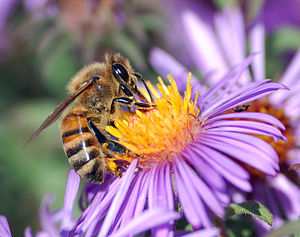 |
| A European honey bee (Wikipedia) |
News that the European Union (EU) has restricted the use of neonicotinoid insecticides was welcomed by scientists, farmers, beekeepers and politicians around the world.
But the limitations of the restriction, as well as the disagreement within the EU, highlight the confusion over exactly what ecological impacts these chemicals have.
Only 15 out of the 27 EU states voted for restricting neonicotinoids, a restriction which will initially only be for two years.
It is also not a complete “ban” - it applies to flowering crops that are attractive to bees and other pollinators, but doesn’t apply to winter cereals or “unattractive” crops.
What are neonicotinoids?
Neonicotinoids are chemically similar to nicotine and they act as a nerve agent on insects. They were developed for commercial use in the 1990s, and are now some of the most-used chemicals in the world.
They can be applied to grown plants or trees, or to seeds. The chemical is then taken up by the growing plant and becomes part of its structure (its roots, leaves, nectar or pollen), so an insect that nibbles on any part of the plant will get a dose of neonicotinoid in its meal.
These doses may not kill the insect immediately, but over time, repeated ingestion of the chemical will build up in the insect’s system and affect its health, behaviour and reproductive success.
This is not so good for non-target insects like pollinators, which are crucial for pollinating our food crops, as well as for overall ecosystem function.
Will the European restrictions make a difference?
Yes. Despite the disagreement, the EU’s moratorium is an important step in the right direction.
It raises much-needed awareness of the ecological impacts of these chemicals, and it will provide some respite for wild pollinators - all those “invisible” insects that are busily keeping plants reproducing in forests, gardens and crop fields.
However, the fact that the ban only applies to some crops means that it will be very difficult to confirm that pollinators are no longer being exposed to the chemical.
How do neonicotinoids affect pollinators?
There have been few studies conducted under natural conditions, which is understandable. Neonicotinoids are almost ubiquitous in the environment; larger insects (like bees) can travel 3-4km to forage; and it is pretty difficult to track and control the movements of most insects!
It would be nearly impossible to ensure that the “control” insect population was not being exposed to insecticides during a field experiment.
However, research combining laboratory and field methods have provided conclusive evidence against various neonicotinoids.
Honeybees exposed to thiamethoxam were more likely to get lost while foraging and not arrive home - this reduces the colony’s food stores and the survival potential of the hive.
Honeybees dosed with imidacloprid also did less “waggle dancing” in the hive, which is how bees communicate the location of food sources to the colony - less dancing means less food collected.
Bumble bee colonies exposed to imidacloprid also struggled - treated colonies showed reduced growth rates and queen production was 85% less than in untreated colonies.
What’s happening in Australia?
Neonicotinoids are widely-used in Australia, and as yet there is no mention of restrictions on their use.
The Australian Pesticides and Veterinary Medicines Authority (APVMA) is currently undertaking a review into these insecticides and the potential risks to honey bee health. They will release a draft consultation report later this year containing their recommendations.
So far, the focus of this review appears to be on honey bees. As many of Australia’s native pollinators are still understudied and undervalued, the impact of neonicotinoids on native insects is unclear.
Given the evidence from European research, and the current stresses that honey bees and wild pollinators are already facing, the EU’s moratorium is inspiring. In this case, the ecological costs far outweigh the application benefits.
Manu Saunders does not work for, consult to, own shares in or receive funding from any company or organisation that would benefit from this article, and has no relevant affiliations.
This article was originally published at The Conversation. Read the original article.

No comments:
Post a Comment